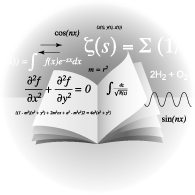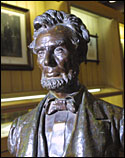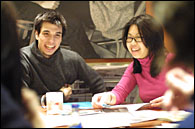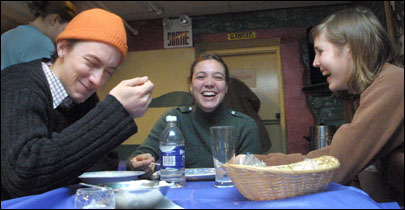On campus
Of course
The art of science writing
 ILLUSTRATION: Tzigane
ILLUSTRATION: Tzigane |
|
Scientists often grumble about journalists who know nothing about the world of science.
Well, the reverse can be true, too -- there are plenty of scientists who don't know how to write about the work they do in a way that doesn't make readers go, "Huh?"
Enter Linda Cooper, the associate director of the Centre for the Study and Teaching of Writing.
Cooper offers a course called "Science Writing and Publishing" to graduate students from science-oriented departments. Last semester she trained a group of young chemists, neuroscientists and engineers to junk the jargon and write clearly.
"Scientists usually aren't taught how to write," observes Cooper. And it shows. Trouble is, all scientists have to write about their work -- for research journals, for grant applications and for conference abstracts.
"Scientists spend an enormous amount of time and care doing their experiments," notes Cooper. "I tell them to devote some of the same attention to writing up their results because the process isn't over until the paper gets published."
One common mistake scientists make when putting together research papers is not being selective enough.
"They've done a lot of work, so it's understandable that they want to include everything. But the reader doesn't want everything. Too much [detail] defeats the force of a paper. I ask students to carefully consider what the real finding is."
In the course, students examine and critique one another's work. They even have to rewrite a classmate's abstract to make sure they understand each other completely. "The students need to cut across disciplines to speak to each other."
To underscore the fact that Cooper isn't just being picky, she asks a journal editor to share his thoughts about writing for the class. Last semester, she recruited pharmacology and therapeutics professor Brian Collier, the editor-in-chief of the Journal of Neurochemistry.
He told the students he appreciates it when he encounters crisp writing that outlines research results clearly. When confronted with jargon and muddled sentences, Collier is much less enthusiastic.
"Clear writing can tip the balance between acceptance and rejection," Cooper says.
The course earned rave reviews from students last semester and even though the class has officially ended, Cooper has kept in touch with her students to see how they've progressed.
"The most important thing that we learned was to be sensitive to the reader and to remember that if we want to share our findings with others, we have to take the time and the effort to write clearly and effectively," says Amira Choukair, a graduate student in the Department of Chemistry.
The course will soon be offered again. An information session for those interested in finding out more will take place March 5 at 9 am in room 627 of the Faculty of Education Building.
Bringing Lincoln north
 Part of McGill's Lincoln collection
Part of McGill's Lincoln collectionPHOTO: Owen Egan |
|
McGill plays host to the most unique and extensive collection of Abraham Lincoln memorabilia north of the U.S. border. So how did we end up with such a significant pile of Abe Lincoln keepsakes?
Joseph Nathanson was a destitute medical student at McGill in the early 1900s. Later success led to a career as a reputable Park Avenue physician.
In the '30s, his daughter had to write an essay on Abe Lincoln and turned to her dad for help. That sparked an intense interest in the man many consider to be the United States' greatest president and led Nathanson to hunt down all things Abraham-related. He eventually donated them to McGill.
When curator Kathleen Toomey first came to McGill as a bibliographer, her office was in the Lincoln room, so she got to know the works very well. A six-month sabbatical spent cataloguing the collection resulted in the Redpath Library's new exhibit, Lincoln North.
"It's a complete collection, in that there are photographs, paintings, monographs by and about Lincoln, his speeches, even some work in Braille," Toomey explains.
Lincoln was the central figure in two of the most important events in U.S. history, the emancipation bill that ended slavery and the U.S. Civil War. The items in the collection illustrate the tone of the times in which Lincoln lived -- a letter from one slave owner quibbling about the price of slaves in Virginia, for instance.
One of the most moving pieces is the diary of surgeon Charles Taft. The 23-year-old Taft was present in the theatre where Lincoln was shot, and tended to the dying president. The collection also includes a certified portion of the blood-stained towel which wrapped Lincoln's head.
Lincoln North at the Lande Reading Room (Lincoln the Man) and in the Redpath-McLennan exhibition area (Lincoln and His Time) runs to April 12, 2002. Call Rare Books (398-4711) for information on tours.
Viewing the East from the West
 Marc Steinberg and Michelle To
Marc Steinberg and Michelle ToPHOTO: Owen Egan |
|
From comic strips to academic treatises, Orientations covers magazine possibilities as broadly as the Asian diaspora covers the globe.
Editors Marc Steinberg (MA student in East Asian studies) and Michelle To (majoring in political science and East Asian studies) explain that Orientations focuses on popular cultural representations of Asia.
"Orientations grew out of an attempt to change people's ideas of Asia. Not just the economic, political, or traditional views, but there needs to be a view of modern, contemporary Asian aspects," Steinberg says.
"We wanted to provide a forum on issues related to Asia, and provide a place where people could submit writing. We have scholarly articles, we're open to photo essays, creative writing -- this year we're publishing a film script of a Montreal film-maker, Yung Chang, on what it's like being part of the Chinese-Canadian diaspora."
They'll also include a piece on Hong Kong architecture, and interviews with Xu Bing, a Chinese artist living in New York City, and Gary Hill, a Seattle-based video artist who is big in the Hong Kong scene.
To says they've advertised for submissions from different McGill departments and other universities, and placed an ad in the Montreal Mirror. They want to get more of the community involved and distribute this April's issue broadly, printing twice as many copies as they did last year. They aim to be accessible and interesting to everyone, not just Asian scholars.
Cheap treats
 Students Benedict Morin, Marisa Berry and Alda Kravec sample the grub at the Rabbit Hole Café
Students Benedict Morin, Marisa Berry and Alda Kravec sample the grub at the Rabbit Hole CaféPHOTO: Owen Egan
The aroma of tasty home cooking wafted up the stairs. Is that curry? My nose alone could have led me down the warren to the subterranean Rabbit Hole Café's Loonie Lunch at the Yellow Door. Alice never knew such wonders.
This initiative is coordinated by Jessica Spector, an international development and English student. Spector says she and Stephanie Hall, coordinator of the Food for Thought collective, "work closely together to make sure everyone on campus is able to have nutritional, healthy and cheap food.
"There's a need within the community for services and support for students having a hard time making ends meet. It's a need that's not talked about much at McGill, but it's still a need," Spector says.
Meals are communal -- if you show up early, you help cook, if you show up later, you help clean.
And bring a loonie or a non-perishable food item. The volunteering "makes people who do need the service more comfortable using the service," Spector says.
The food is vegetarian with vegan options. The "guest chef" that week, anthropology and economics student Shika Nandkeolyar, had people whip up a madras curry with potatoes and tofu, and a chickpea spinach dish to go with rice. Bowls of yogurt sat on the tables. "I come once a week, usually as a minion, chopping and stuff," Nandkeolyar says. As we chatted, a well-fed student thanked her, saying it was excellent. Others lined up to do their own dishes.
Past meals have included lentils and couscous, the student staple of pasta and sauce, and veggie "meat" with tacos/tortillas.
Spector says they're still figuring out the logistics of shopping, task divisions, publicity, etc., and they hope to expand lunches to Tuesdays as well.
The Rabbit Hole Café offers loonie lunches at the Yellow Door, 3625 Aylmer, on Fridays, 12:30 pm - 2:30 pm.

